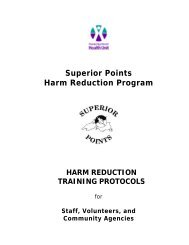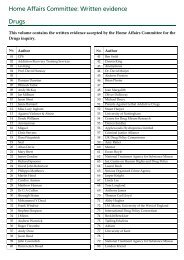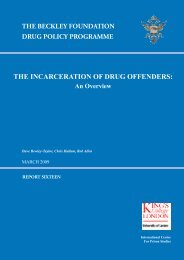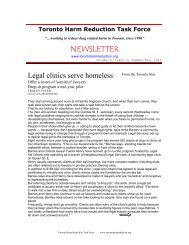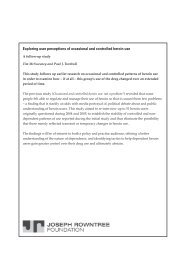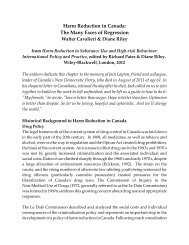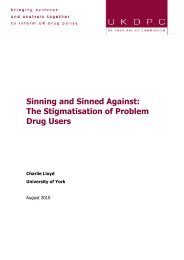A Preliminary Bibliography on Injection Drug Use and Users (IDU) in ...
A Preliminary Bibliography on Injection Drug Use and Users (IDU) in ...
A Preliminary Bibliography on Injection Drug Use and Users (IDU) in ...
Create successful ePaper yourself
Turn your PDF publications into a flip-book with our unique Google optimized e-Paper software.
Abstract: Objective. To identify who are the drug users shar<strong>in</strong>g <strong>in</strong>jecti<strong>on</strong>material. Methods. In Quebec City, 618 <strong>in</strong>jecti<strong>on</strong> drug users (<strong>IDU</strong>) who used theservices of a needle syr<strong>in</strong>ge exchange program (8.4% HIV+) participated <strong>in</strong> aface-to-face <strong>in</strong>terview. Informati<strong>on</strong> regard<strong>in</strong>g behavioral variables related to thelast 6 m<strong>on</strong>ths as well as sociodemographic variables were obta<strong>in</strong>ed. A logisticregressi<strong>on</strong> analysis was performed <strong>on</strong> two models of shar<strong>in</strong>g needles dur<strong>in</strong>g thelast 6 m<strong>on</strong>ths. The first model compared those shar<strong>in</strong>g <strong>IDU</strong> with those who d<strong>on</strong>ot; the sec<strong>on</strong>d model was based <strong>on</strong>ly <strong>on</strong> shar<strong>in</strong>g <strong>IDU</strong> <strong>and</strong> subdivided them <strong>in</strong> 3groups: those who lended (n=78), borrowed (n=102), or lended <strong>and</strong> borrowed(n=153) <strong>in</strong>jecti<strong>on</strong> material. Results. In the first model, several variables appearedto discrim<strong>in</strong>ate shar<strong>in</strong>g <strong>IDU</strong> from n<strong>on</strong>-shar<strong>in</strong>g <strong>IDU</strong>. These variables were: liv<strong>in</strong>g<strong>in</strong> a shoot<strong>in</strong>g gallery (OR: 4.6, CI95%: 1.5;14.2); the number of hits with the sameneedle syr<strong>in</strong>ge (OR greater than 1 hit: 2.9, CI95%: 1.8;4.6); <strong>in</strong>ject<strong>in</strong>g with anacqua<strong>in</strong>tance (OR: 2.7, CI95%: 1.7;4.2); hero<strong>in</strong> users (OR: 2.2, CI 95%: 1.3;3.5);<strong>in</strong>ject<strong>in</strong>g <strong>in</strong> a shoot<strong>in</strong>g gallery (OR greater than 10 times: 2.1, CI95%: 1.2;3.6); formales, hav<strong>in</strong>g male sexual partners (OR: 2.3, CI95%: 1.3;4.1) <strong>and</strong> age at the<strong>in</strong>terview (OR: 0.97, CI95%: 0.95;0.99). In the sec<strong>on</strong>d model, the discrim<strong>in</strong>at<strong>in</strong>gvariables differed between each logistic equati<strong>on</strong> (<strong>IDU</strong> wholended/borrowed/lended <strong>and</strong> borrowed); <strong>and</strong> also differed from the variable <strong>in</strong>the first model. C<strong>on</strong>clusi<strong>on</strong>. Important variables discrim<strong>in</strong>ate those who sharefrom those who do not share. There is evidence that type of shar<strong>in</strong>g is alsorelated to specific variables.This study was supported by a grant from the Nati<strong>on</strong>al Health Research <strong>and</strong>Development Program, Health Canada.Bruneau J, et al. (1997) High rates of HIV <strong>in</strong>fecti<strong>on</strong> am<strong>on</strong>g <strong>in</strong>jecti<strong>on</strong> drug usersparticipat<strong>in</strong>g <strong>in</strong> needle exchange programs <strong>in</strong> M<strong>on</strong>treal: results of a cohort study.American Journal of Epidemiology 146:994-1002Abstract: The associati<strong>on</strong> between NEP [needle exchange programs] use <strong>and</strong>HIV <strong>in</strong>fecti<strong>on</strong> was exam<strong>in</strong>ed <strong>in</strong> three risk assessment scenarios us<strong>in</strong>g <strong>in</strong>tensivecovariate adjustment for empirical c<strong>on</strong>founders: a cross-secti<strong>on</strong>al analysis of NEPuse at entry as a determ<strong>in</strong>ant of seroprevalence, a cohort analysis of NEP use atentry as a predictor of subsequent seroc<strong>on</strong>versi<strong>on</strong>, <strong>and</strong> a nested case-c<strong>on</strong>trolanalysis of NEP participati<strong>on</strong> dur<strong>in</strong>g follow-up as a predictor of seroc<strong>on</strong>versi<strong>on</strong>.[...] Risk elevati<strong>on</strong>s for HIV <strong>in</strong>fecti<strong>on</strong> associated with NEP attendance weresubstantial <strong>and</strong> c<strong>on</strong>sistent <strong>in</strong> all three risk assessment scenarios <strong>in</strong> our cohort of<strong>in</strong>jecti<strong>on</strong> drug users, despite extensive adjustment for c<strong>on</strong>founders. In summary,<strong>in</strong> M<strong>on</strong>treal, NEP users appear to have higher seroc<strong>on</strong>versi<strong>on</strong> rates than NEPn<strong>on</strong>users. (Author) This research was funded by a grant from the Nati<strong>on</strong>alHealth Research <strong>and</strong>Development Program, Health Canada.




